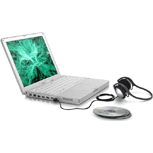Computing News
Apple’s Latest iBookNote: This document has been revised since it was first published as a news article in May, 2001. The original article is here.

On October 16, 2001, Apple Computer announced an updated version of their iBook laptop line. This system, currently available only in white, represents primarily a speed update to the "consumer portable" portion of Apple's four-part product line.
The iBook weighs in at 4.9 lbs, comes in three standard configurations and can be custom built at Penn's Apple Store.
What it has
- 500 or 600 MHz G3 processor with 256K on-chip level 2 cache
- System bus speeds of 66MHz for the 500MHz model, and 100MHz for the 600MHz model.
- 128MB of RAM, expandable to 640MB
- 10/100BaseT Ethernet and 56 kbps modem
- Internal slot for AirPort Card
- Two 12 Mbps USB ports for connecting low-speed devices
- One 400 Mbps FireWire (IEEE 1394) port
- 12.1-inch active matrix LCD display with 1024 x 768 maximum (native) resolution
- ATI Rage Mobility graphics accelerator with 8MB of SDRAM and AGP 2X support
- RGB video output port and composite video output through AV port
- 15 GB or 20 GB hard disk (depending on configuration)
- CD-ROM, CD-RW, DVD-ROM, or CD-RW/DVD-ROM combo drive
- Stereo speakers
- Mac OS 9.2.1 (default) and Mac OS 10.1 in a dual-boot configuration
What it doesn’t have (that the PowerBook G4 does)
- VGA connector
- PC Card (PCMCIA) slot
- IR port
Standard configurations
The iBook is offered in three standard configurations at the Computer Connection:
- 500 MHz G3/128 Mbytes RAM/15 Gbyte hard drive/24x CD-ROM drive
- 600 MHz G3/128 Mbytes RAM/15 Gbyte hard drive/8x DVD-ROM drive
- 600 MHz G3/128 Mbytes RAM/20 Gbyte hard drive/4x4x24 CD-RW/ 6x DVD-ROM combo drive
Additional build-to-order (BTO) options are available.
Technical issues & recommendations
ISC does not expect there to be significant hardware-related compatibility problems with the iBook. However, the iBook will have the same software-related conflicts that any Mac OS 9.2.1-based or Mac OS X version 10.1-based workstation would have.
ISC has tested the iBook for compatibility with University-supported hardware and software. The iBook is compatible with the 2001 PennConnect CD-ROM and with Penn’s supported network applications. Attention has also been paid to dial-up networking and modem functionality, which has been tested using a modified version of ISC’s modem testing script.
Depending on how well configured they are, these workstations meet either ISC’s Recommended Configurations for New Value Laptop Workstations or ISC’s Recommended Configurations for New Lightweight Laptop Workstations. Please note that ISC considers 256 MB of RAM to be the absolute minimum for a new workstation. As always, support providers should be aware of the technical issues associated with any new workstation design.
--Robert L. DeSilets, Jr., IT Support Specialist, ISC Provider Desk
[an error occurred while processing this directive]
[an error occurred while processing this directive]